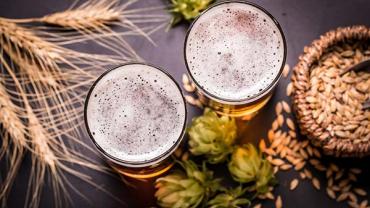
Alcohol is a perennial hop topic in health and nutrition. Headlines in the mainstream press seem to fluctuate between dire warnings about the perils of even modest alcohol consumption and the health benefits of regularly imbibing. One day, a “daily glass of wine increases risk of early death by 20%”; another day, “having a drink may help you live longer.” If you listen to AARP (formerly the American Association of Retired Persons), “moderate drinking is as bad for your health as smoking.” But Pacific Standard reported “drinking is healthy.” It’s impossible to keep up with the changing tides, and the truth about alcohol most likely lies somewhere in the middle of the large chasm between beneficial and harmful. Harvard University’s Chan School of Public Health said it well: “alcohol is both a tonic and a poison. The difference lies mostly in the dose.”
According to the US National Institutes of Health, one drink is considered to be 0.5 ounces or 15
grams of alcohol, equivalent to 12 oz of beer (5% alcohol), 5 oz wine (12% alcohol), or 1.5 oz of 80-proof distilled spirits (~40% alcohol). The USDA defines “moderate” alcohol consumption as up to 1 drink per day for women and up to 2 drinks per day for men. “Heavy” or “high-risk” drinking is consuming more than 3 drinks on any day or more than 7 per week for women and more than 4 drinks on any day or more than 14 per week for men.
According to the USDA’s Dietary Guidelines from 2010, in the US, approximately 50 percent of adults were regular drinkers and 14 percent were infrequent drinkers. About 9 percent of men consumed an average of more than two drinks per day and 4 percent of women consumed an average of more than one drink per day. There are about 1.5 billion episodes of binge drinking annually in the US. Binge drinking is defined as consuming 5 or more drinks within 2 hours for men and 4 or more drinks within 2 hours for women. Oregon State University’s Linus Pauling Institute does not mince words about heavy alcohol consumption. They list the health benefits of heavy alcohol consumption as: none.
It’s well-known that alcohol consumption affects the pharmacodynamics of medications. This issue is important across all adult age groups but may be particularly germane among older adults, who may be taking several medications while not being as forthcoming about their alcohol intake. A lesser appreciated effect of alcohol consumption is impairment of prospective memory, which one paper describes as “the cognitive ability of remembering to carry out an intended action at some future point in time.” Prospective memory (PM) is an indispensable part of everyday functioning, because it’s involved in activities such as remembering to keep appointments or to take medications on time.
A recent study showed that subjects (college students) who were hung over (defined as “the presence of a combination of both mental and physical symptoms experienced the day after a single episode of heavy drinking […] which begin when the blood alcohol concentration approaches zero) had significantly impaired PM compared to those who were not hung over. Anyone who’s ever tossed back one too many knows that cognitive impairment occurs during acute intoxication, but it may be news for some that the decline in memory and cognition can be as great or greater during a hangover, when the blood alcohol level is zero.
It’s one thing to meet coworkers for a few drinks after work one night, but many may not realize that if they drink a bit more than they should, the negative effects can persist well into the next day, and they go far beyond a headache and nausea. Divided attention, delayed recognition and reaction time can be a hazardous factor for anyone driving or operating machinery, and for people in more cerebral professions, it can affect overall cognitive performance. A 2018 systematic review looking at the next‐day effects of heavy alcohol consumption on cognitive performance found that “sustained attention and driving abilities were impaired during hangover.” Maybe it’s time to raise attention not only on driving under the influence and driving while intoxicated, but on driving while hungover, or driving “after” the influence.
Heavy drinking also affects nutrient status. Heavy drinkers may have poor absorption of B-vitamins, and the conversion of B-vitamins to their active forms is impaired by alcohol. Most heavy drinkers are deficient in a host of B-vitamins. Magnesium deficiency is also common among heavy drinkers. Adequate zinc status is essential for liver processing of alcohol; the main enzymes involved in the detoxification of alcohol are zinc-dependent. Alcohol consumption increases urinary losses of zinc, calcium and magnesium. Individuals who consume large amounts of alcohol should make an effort to consume a nutrient-dense diet and supplement under the care of a medical or nutrition professional while working to decrease their habitual alcohol intake.
Alcohol can be enjoyed responsibly and in moderation, and a designated driver should always be used. Having a drink or two with friends may be a reasonable means of relaxation after a tough day, but all should remember that there’s potential for adverse lingering effects long after the alcohol has been metabolized.